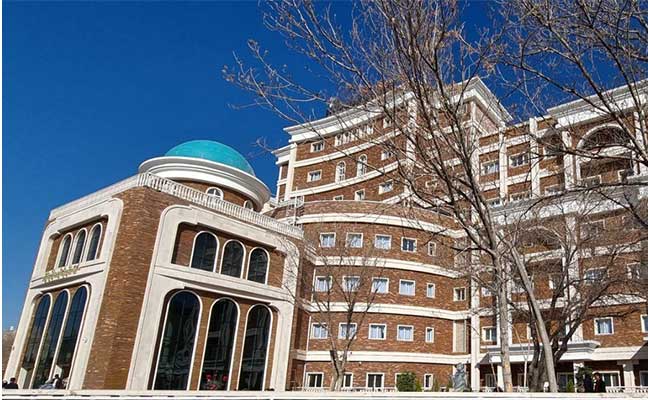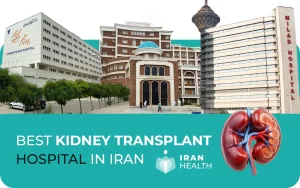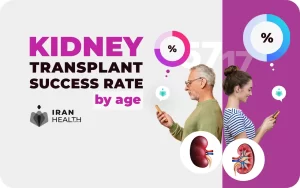Kidney Transplant in Iran
Are you looking for Kidney Transplant?
With the best result and the safest trip?
Contact us now!
- Duration minimum:4-5 Hours
- hospital Stay: 17 Day
- Anesthesia: General
- Clinic Stay: 30 Day
- Recovery: 1 -2 months
Kidney transplants in Iran cost
Kidney transplants in Iran are much more affordable than in most other countries. The Iranian government covers the costs of the procedure, hospital stay, drugs, and follow-up care for Iranian citizens.
For non-Iranians, the typical cost of a kidney transplant in Iran ranges from $13,000-$17,000. Surgeons’ fees, hospital fees, drugs, etc. Much lower than the US and Europe.
Hospitals

Firouzgar Hospital
Hospital beds : +400
Legacy & Affiliation: Founded in 1951, affiliated with the Iran University of Medical Sciences. Comprehensive Services: 435 beds, 34 operating rooms, diverse specialties. Education & Training: Vital role in training interns, residents, and allied professionals. Specialties: Provides gastrointestinal, cardiac, cancer, and rehabilitation services. Research & Quality: A beacon in research, quality management, and patient rights. Intervention Services: Leading in cardiac and brain vascular interventions.

Shahid Hashemi Nejad Hospital
Hospital beds : +400
Established in 1957 with 190 beds under the Ministry of Health and Iran University of Medical Sciences, the hospital has evolved into a national center for Urology, Nephrology, Hemodialysis, and Transplants since 1985. Committed to excellence, it has implemented quality models such as EFQM, ISO, JCI, Clinical Governance, BSM, and National Accreditation, leading to significant advancements in both the quality and scope of its specialty services.

Abu Ali Sina Hospital
Hospital beds : +150
Ebnesina Hospital was established in June 2007, following the former Ebnesina clinic, which served patients since 1973. The hospital, named after the renowned 10th-century Iranian polymath and physician, Avicenna or Ibn Sina, is situated in the Sadeghieh district in Tehran. Despite the construction of several medical centers in the region over the years, Ebnesina Hospital remains the most esteemed one.
Kidney Transplant in Iran for Foreigners
Many patients are opting to travel abroad for kidney transplants (renal transplantation) due to long waiting lists and costly medical procedures in their home countries.
Some nations provide specialized kidney doctors and transplant centers with minimal or no wait times for surgery, at a lower price point. To qualify for a transplant abroad, patients typically need to arrange for an accompanying living donor.
Policies on donor eligibility vary – some destinations require organ donors to be a blood relative of the recipient, while others, like Iran, permit donors of the same nationality. Traveling internationally enables access to transplantation at an accelerated timeline and reduced cost, although patients must navigate different regulations regarding qualifying living donors.
Iran has become a top global provider of kidney transplants. The nation does over 4,000 kidney transplants per year, utilizing both living and deceased donors, to transform and save lives for those with renal disease. Iran’s stellar medical infrastructure allows kidney transplant operations to occur frequently and efficiently. Patients from over 50 different countries come to Iran annually to receive affordable kidney transplants performed by top-class medical teams.
Organ transplantation in Iran opens up affordable treatment possibilities that meet and exceed global healthcare standards. Iran has several high-quality transplant facilities equipped with cutting-edge technology and extensive medical knowledge.
Duration of Kidney Transplant in Iran
| Step | Description | Duration |
| Pre-surgery preparations | Pre-surgery checkups, medical & legal approval | Minimum 7 to 14 days |
| Surgery | The operation itself | 4-5 hours or more |
| Post-surgery hospitalization for the donor | Recovery time in the hospital for the donor | Minimum 2 nights |
| Post-surgery hospitalization for the recipient | Recovery time in the hospital for the recipient | Minimum 7 nights |
| Post-hospitalization check-up in Iran for the recipient | Follow-up visits in Iran for the recipient | Minimum 7 nights |
Expert in Kideny Transplant
Please review doctors’ portfolios and select the best one based on their experience.
- Iran has some highly skilled and experienced transplant surgeons. Many were trained internationally before returning to practice in Iran.
- Iranian surgeons perform over 3,500 kidney transplants every year. This high volume has helped them develop expertise.
- Success rates of transplantation in Iran are comparable to averages in developed countries. One-year graft survival rates exceed 90%.
- Short waiting times for organs also make outcomes better compared to countries with long queues.

Preparing for a Kidney Transplant in Iran
Those seeking a kidney implant in Iran must go through certain medical and legal steps before the surgery can take place.
Getting Medical Clearance
Both the organ recipient and donor must undergo comprehensive health evaluations in Iran, even if they’ve had checks done elsewhere. These mandatory pre-surgery tests include:
- Dental exam
- Cardiac health check
- ENT evaluation
- Gastroenterology screening
- Endoscopy
- Full kidney function blood work panel
- Kidney CT scan
- Final approval from a nephrologist
Ideally, the medical clearance process takes about 12 to 14 working days. If any health issues come up during the exams, more time may be needed to treat those conditions before approval is given. Once fully cleared, the hospital drafts a letter to legal authorities requesting permission to perform the transplant.
Navigating Legal Approval
Recipients and donors must have their identity and citizenship authenticated by their embassy in Iran. This verification, along with the hospital’s letter, gets submitted to Iran’s Ministry of Health to secure final authorization for surgery, typically in 7-10 working days.
Continuing Dialysis
The patient will need to continue dialysis on their regular schedule at the transplant hospital during the preparation period. Our team schedules these sessions upon arrival. The hospital requires current negative Hepatitis and HIV tests to administer dialysis. These can be taken either in the patient’s home country or after arriving in Iran.

Personal Experience
Remember the day I made the decision: no more dialysis, no more not knowing. It was scary to go to Iran for my kidney transplant, but it was also strangely hopeful. The hospital I was sent to had a well-known transplant team, and when I met the doctors, I could tell they were calm and confident. They went over the plan, the donor's history, and the medications that would be needed after the surgery. Everything was clear.
It was a hard surgery that lasted for hours and was a big deal, but when I woke up, I felt something I hadn't felt in years: relief. The next few days were hard, and the nights were long, but the team was there to take care of me, check my vitals, and cheer me on. My life changed when I got back home. I could plan simple things like going for a walk in the park, meeting friends, and eating without worrying about my health or dialysis schedules.
How is kidney transplant surgery performed?
If you are informed that your kidneys are not functioning properly, a transplant may be required.
This involves a surgical procedure where you receive a kidney from another person via organ transplant. The surgery typically lasts between two to four hours, during which you will be under anesthesia and won’t experience any pain.
The new kidney will be sewn into your belly through a little opening made by the doctor. The new kidney will be connected to your blood vessels and bladder, so it can function like your old ones. Depending on how it looks, the doctor might remove your old kidneys or just leave them there.
You will have a few tubes in your arms, neck, and bladder to assist with fluids (infusions), medications, or urinating.
You will spend three or four days in the hospital after surgery to make sure your new kidney is functioning properly. To prevent your body from rejecting the new kidney, you have to take some medicine. Therefore your body may believe the newly transplanted kidney is not yours and reject it. You also have to eat properly and take care of yourself in order not to damage your new kidney.
A kidney transplant will make you feel better and live longer. On the other hand, there are also some dangers and problems of this approach-for example: getting an infection; bleeding or having a blood clot from the transplant surgery; rejecting your new kidney. You can talk to your doctor about the pros and cons of a kidney transplant, whether you’re a good candidate for it or not.

The key points of kidney transplant surgery
- A kidney transplant is a surgical procedure that lasts 2-4 hours.
- You will be under general anesthesia, which means you will not feel any pain or be awake.
- The surgeon will choose the best method to place the new kidney in your body and explain it to you before the surgery. You will have tubes in your arms, neck, and bladder to deliver medicines and fluids and to drain your urine.
- Most people only need one new kidney, but some may need two (this is called dual kidney transplantation).
Main criteria for donating a kidney:
- Age: Most programs accept living kidney donors between 18-65 years old. There may be some flexibility on the upper age limit for older donors who are in excellent health.
- Health: Potential donors undergo medical tests to evaluate their physical health and kidney function. Doctors look for issues like high blood pressure, diabetes, kidney disease, cancer, or heart disease that could make donating risky or cause problems later.
- Blood type: Ideally the donor’s blood type should match or be compatible with the recipient’s, except in rare cases of an AB blood type recipient.
- Antibody matching: Crossmatching tests are done to ensure the recipient does not have antibodies that would lead to rejection of the donor’s kidney.
- Relation to recipient: Priority is given to donating to a spouse, blood relative, or close friend. Stranger kidney donations are also accepted.
- Motivation: Donors should be making the choice freely without coercion or payment, and understand the risks. Their motivation matters more than their relationship.
- Support system: Donors need a good support system to help them during the testing phase as well as recovery after surgery.
- Psychological assessment: Evaluation by a psychologist or psychiatrist may be required to confirm the donor is mentally fit.
The decision also involves consultation with the donor’s family, extensive discussions with the transplant team, and a full consent process covering the surgery and risks.
Finding a Kidney Donor Match
Before getting a kidney transplant, tests are done to find a good match between you and the kidney donor.
Matching factors include:
- Blood Type:
It’s best to get a kidney from a donor with the same or a compatible blood type as yours. Transplants with incompatible blood types are possible but require additional treatment
Recipient blood type | Donor blood type |
O | O |
A | A or O |
B | B or O |
AB | Any blood type |
- Tissue Typing:
A test called HLA typing compares genetic markers to see if the kidney is less likely to be rejected. A good match means the kidney may last longer.
- Crossmatch:
Your blood is mixed with the donor’s blood to see if your antibodies will react to the donor’s antigens. A negative crossmatch means you are more compatible.
Living Donor Options
If a family member or someone else offers to donate but isn’t a good match, a paired donation can be done – your donor gives a kidney to someone else, while you get a kidney from that person’s donor. Chain donation involves multiple donor/recipient pairs.
Staying Healthy While Waiting:
- Take medications as prescribed and follow your diet and exercise plan
- Don’t smoke
- Keep all medical appointments
- Stay active and reduce stress
- Notify the transplant team about any health changes
The Transplant Procedure
During surgery under anesthesia:
- The new kidney is placed in your lower abdomen, attached to your blood vessels and bladder
- Your original kidneys are usually left in place

Kidney Transplant Success Rate by Age in Iran
Kidney transplant success rates in Iran are comparable to those reported in the U.S. and Europe, with outcomes depending partly on the recipient’s age. For younger patients (under 35), one-year graft survival rates often exceed 95%, reflecting strong immunity, better tolerance of immunosuppressants, and lower comorbidity levels.
Patients between 35 and 50 generally achieve 90–93% one-year survival rates, which remain very favorable. For recipients over 60, survival rates are slightly lower, typically around 85–88% after one year, mainly due to pre-existing conditions like diabetes, hypertension, and cardiovascular disease rather than the transplant itself.
Importantly, long-term follow-up studies from Iranian centers show that even older recipients benefit from significant life expectancy gains compared to dialysis, often enjoying 8–12 additional quality-adjusted years of life. Success is also influenced by the donor’s age and health, adherence to immunosuppressive therapy, and the patient’s overall lifestyle. Clinics in Iran emphasize tailored immunosuppressant protocols for older patients to balance infection risk with graft protection.
This age-specific data helps families make informed decisions and reassures patients that Iran’s transplant programs deliver globally competitive results across all age groups.
Is a kidney transplant still recommended for older patients over 60?
Yes. While graft survival rates are slightly lower in older recipients, studies in Iran and globally show that kidney transplant still offers major survival and quality-of-life benefits compared to dialysis, often extending life expectancy by a decade or more.

After undergoing kidney replacement surgery:
For many individuals battling chronic kidney disease, renal transplant surgery offers a chance at renewed freedom and improved quality of life.
While it presents a significant step towards reclaiming health, undergoing a kidney transplant operation also involves important considerations regarding post-surgical care, medication adherence, and potential long-term adjustments.
After the Transplant
- Spend several days in the hospital as doctors monitor for complications
- Expect pain and soreness during recovery
- Have frequent checkups to ensure the new kidney works properly
- May need blood tests several times a week to check for rejection
- Will need to take immunosuppressant medications lifelong to prevent kidney rejection.
Important Notice:
Getting a new kidney can add years of quality living, but there are no guarantees. Success depends on many factors. National registries track how well transplants are working over time. The numbers show many people go 5, 10, or even 15+ years before having any kidney trouble. Others run into challenges sooner despite best efforts.
If your new kidney fails down the road, you’ll feel disappointed and frustrated. But don’t lose hope. You have options and can make the best decision for you at that time.
You may choose to resume dialysis if you tolerated it all right before. Improved dialysis methods make this feasible for some. Or you could discuss a second transplant with your team, depending on your age and health.
Unfortunately, over time the immune system may reject a second kidney too. And at some point, multiple major surgeries take their toll. If you feel you’ve exhausted treatment options and your quality of life is too disrupted, you may make the very personal decision to stop dialysis and focus solely on feeling as well as possible.
Your transplant team includes nurses, social workers, and palliative care specialists who provide support through any choice you make. They will try to control pain, nausea, and fatigue and guide you and your family on what to expect. The goal is always to help you live life in keeping with your values and priorities.
Let’s dive into more details about kidney surgery aftercare:
- Hospital Recovery
- Initial hospital stay ranges from 3-7 days on average. May be longer if complications occur.
- IV fluids and medications are given to support kidney function. Tubes drain urine and fluid from the surgical site.
- Doctors and nurses monitor wound healing, urine output, medications, and overall recovery 24/7 during hospitalization.
- Discharge education begins covering self-care, restrictions, and medication schedules.
- Medications
- Anti-rejection meds suppress the immune system so the body doesn’t attack new kidneys. Taken daily.
- Steroids like prednisone help prevent rejection. High dose initially, tapered over months.
- Other meds treat side effects like infection, high BP, nausea or adjust bone/iron levels affected by immunosuppressants.
- Strict adherence to a medication schedule is extremely important in life. Missing doses can lead to rejection.
- Follow-up Testing & Monitoring
- Frequent lab work checks kidney function, electrolytes, nutrient levels, and medication concentrations.
- May need frequent biopsy, scans, or other testing to monitor for complications like infections or rejection.
- Ongoing coordination of care from transplant nephrologist, surgeon, pharmacist, social worker, dietitian.
- Lifestyle Changes
- Strict hand hygiene, food safety, and avoiding sick contacts to prevent dangerous infections.
- Eating a healthy, low-salt, low-fat diet. Likely nutrient supplements. Fluid intake goals.
- Activity and exercise guidelines gradually relaxed as recovery progresses.
- Work/school/travel restrictions were eventually lifted by the care team.
- Avoiding Rejection
- Transplants can be put at risk if medication is not taken on time, levels are not checked, or follow-up is inadequate.
- The chances of acute rejection are highest in the first six months. The patient should be monitored for the rest of his life.
- There is a method of identifying rejection by biopsy and changing the treatment following it.
- Ongoing Education
- Learning medication names/doses/side effects, lab values, danger signs, and who to call with questions/concerns.
- Preventing and identifying infections, avoiding hazards, drug/food interactions, and coordinating care.
- Psych education on coping strategies, lifestyle adjustment, and grief over the loss of an old organ.
- Emotional Support (kidney replacement therapy)
- Social workers and mental health resources help adjust to stress and life changes.
- Peer support groups connect recipients to share experiences, and lessons learned.
- Be proactive in processing grief and identity changes. Taking time to celebrate a second chance at health.
FAQ About Kidney Transplant in Iran
Is kidney transplant legal in Iran?
Kidney transplant is legal in Iran and it has a unique system of living-unrelated donation that is regulated and funded by the government.
Which is the best hospital for kidney transplant in Iran?
The best hospital for kidney transplants in Iran may depend on various factors such as the location, the cost, the quality of care, and the availability of donors. Some of the hospitals that offer kidney transplants in Iran are Imam Khomeini Hospital, Shariati Hospital, Hasheminejad Hospital, Milad Hospital in Tehran, and Shiraz Transplant Center in Shiraz.
Is there a waiting list for kidney transplant in Iran?
There is no waiting list for kidney transplants in Iran because of the high number of living donors who are compensated by the government and the recipient. This has eliminated the shortage of donor organs and reduced the mortality rate of patients with end-stage kidney disease.
How long does it take to get a kidney transplant in Iran?
The duration of kidney transplant in Iran may vary depending on the individual case and the availability of the donor organ. However, the average time from the initial evaluation to surgery is about 3 to 4 weeks. The surgery itself lasts 2 to 4 hours and the hospital stay is 7 to 10 days. The minimum stay in Iran for the recipient is 10 days and for the donor is 7 days.
Which country is best for kidney transplant?
The best country for a kidney transplant may depend on your personal preferences, medical needs, and financial situation. Some of the factors that you may want to consider are the success rate, the cost, the quality of care, the legal and ethical issues, and the travel and accommodation arrangements. Some of the countries that are known for kidney transplants are the US, the UK, India, Turkey, and Iran.
Which country is the easiest to get a kidney transplant?
The easiest country to get a kidney transplant may also depend on your specific circumstances and expectations. However, some of the countries that have shorter waiting times, lower costs, and higher availability of donor organs are Iran, India, Pakistan, and the Philippines. These countries have different systems of organ donation that may involve living or deceased donors, voluntary or compensated donation, and legal or illegal trade. You should be aware of the risks and benefits of each option before making a decision.
How many kidney transplants are there in Iran?
According to the latest statistics, there were 3,551 kidney transplants performed in Iran in 2019. Of these, 3,461 were from living donors and 90 were from deceased donors. Iran has the highest rate of living donor kidney transplantation in the world, with 41.6 per million population.
Who is not suitable for kidney transplant?
Additionally, some people may not be able to have a kidney transplant because they are unable or unwilling to follow the strict medication regimen and lifestyle changes required after the surgery. These include smoking, drinking alcohol excessively, using illicit drugs, and not taking immune-suppressing medicines regularly.
How long can you live with one kidney?
Most people with one kidney live healthy, normal lives with few problems. However, some people may have a slightly higher risk of developing high blood pressure, fluid retention, and proteinuria later in life. The loss in kidney function is usually very mild, and life span is normal.
What is the maximum age for kidney transplant?
There is no specific upper age limit for kidney transplant, as long as the person is healthy enough to undergo the surgery and take the medications needed after the transplant. The American Society of Transplantation’s guidelines state “There should be no absolute upper age limit for excluding patients whose overall health and life situation suggest that transplantation will be beneficial.” 3
Who is not suitable for kidney transplant?
some people are not suitable for a kidney transplant because they have serious medical conditions that make the surgery too risky or unlikely to succeed. These conditions include severe heart disease, cancer, serious infection, liver disease, and others.
Additionally, some people may not be able to have a kidney transplant because they are unable or unwilling to follow the strict medication regimen and lifestyle changes required after the surgery. These include smoking, drinking alcohol excessively, using illicit drugs, and not taking immune-suppressing medicines regularly.
Related post

Best kidney transplant hospitals in Iran
We have identified seven of the best kidney transplant hospitals in Iran, all with professional expertise in treating kidney disease and performing dialysis. Below, we introduce some of the best

Maximum life after kidney transplant
What is the most extended life after a kidney transplant? How long can someone live after getting a new kidney? Well, the good news is that many transplant recipients have

Kidney Transplant Success Rate by Age
IranHealthAgency’s patients always have concerns about their age! Is everything going smoothly, even though I’m not young anymore? One of our patients was over 50 and even had open-heart surgery,


When I found out I needed a kidney transplant, I was worried about the quality and safety of the surgery abroad. The Iran Health Agency set up everything for me, including the hospital, specialist surgeons, and follow-ups. They also helped me every step of the way. I am getting better, and I feel hopeful again
It worked, but man it was a ride.
Did my kidney transplant in Tehran through Iran Health Agency in March 2025. Paid $14,800 total (including donor, hospital, meds, hotel, everything). That’s insane compared to the £120k+ I was quoted in the UK, so on price alone it’s a win.
The good: zero waiting list, surgery was smooth, surgeon was legit (did like 800+ transplants), hospital was cleaner than some private ones I’ve seen back home. I’m 8 months post-op now, creatinine is stable, no rejection so far. Their coordinator (shoutout to Soheila) was an actual angel with WhatsApp replies at 2 a.m.